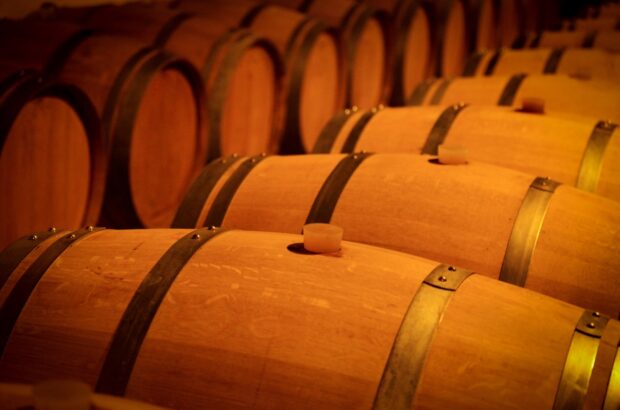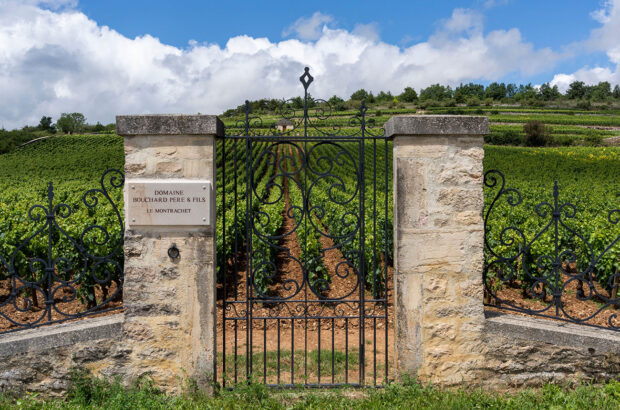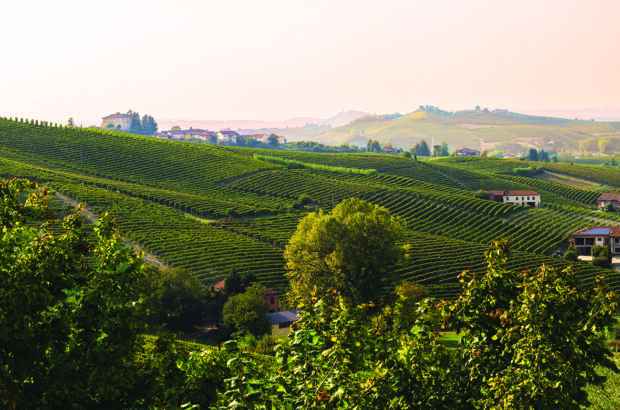This small, northerly corner of Tuscany has a long, noble history. But can its complex terroirs and the passion of its producers ever lift Carmignano’s DOCG wines above the clamour for Chianti? Stephen Brook visits the region…
Enrico Pierazzuoli, one of the brothers who own the Le Farnete estate in Tuscany, is standing among his vines shortly before harvest. ‘I’m not sitting at a computer or staring at analyses before harvest,’ he tells me.
‘I’m here in the vineyard. I’m not against technology. You can use GPS and drones and soil probes, but then you have to make a decision, and this you can only do if you are in the vines every day. Knowing about one element is not enough. You need to taste the berries, you need to observe the vines. Only then will you arrive at the correct decision.’
Scroll down for Stephen Brook’s top 10 Carmignano reds
I dare say any good grape farmer would agree with him. But Pierazzuoli has another concern: he has to assemble a wine that, by definition, must blend different varieties.
We’re in the Carmignano appellation, which has a majority of Sangiovese, and significant supporting roles for Cabernet Sauvignon and/ or Cabernet Franc, Merlot and perhaps Syrah or Petit Verdot too.
{"content":"PHA+V2hlcmUsIHlvdSBtYXkgd29uZGVyLCBpcyBDYXJtaWduYW5vP0l04oCZcyBhIHNtYWxsIHJlZ2lvbiBvZiAyMDAgaGVjdGFyZXMgdGhhdCBsaWVzIGFib3V0IDIwa20gd2VzdCBvZiBGbG9yZW5jZSBhbG9uZyB0aGUgYmFzZSBvZiB0aGUgTW9udGFsYmFubyBtb3VudGFpbiBhbmQgb3Zlcmxvb2tpbmcgdGhlIGluZHVzdHJpYWwgdG93biBvZiBQcmF0by48L3A+CjxwPjxkaXYgY2xhc3M9ImFkLWNvbnRhaW5lciBhZC1jb250YWluZXItLW1vYmlsZSI+PGRpdiBpZD0icG9zdC1pbmxpbmUtMiIgY2xhc3M9ImlwYy1hZHZlcnQiPjwvZGl2PjwvZGl2PjwvcD4KPHA+SXQgYmVjYW1lIGEgZGVsaW1pdGVkIHZpbmV5YXJkIHpvbmUgdW5kZXIgdGhlIE1lZGljaXMgaW4gMTcxNiwgYW5kIGNlbGVicmF0ZWQgaXRzIDMwMHRoIGJpcnRoZGF5IGxhc3QgeWVhci4gSXQgd2FzIHRoZSBNZWRpY2lzIHdobyBhcHBhcmVudGx5IGltcG9ydGVkIENhYmVybmV0IFNhdXZpZ25vbiB0byBiZSBwbGFudGVkIGhlcmUgYW5kIHRodXMgY3JlYXRlZCB0aGUgd2luZSB0aGF0IHN0aWxsIGV4aXN0cyB0b2RheS48L3A+CjxwPlRoZSBkZWNyZWUgb2YgMTcxNiBtYWtlcyBubyBtZW50aW9uIG9mIGdyYXBlIHZhcmlldGllcywgdGhvdWdoIHRoaXMgZG9lcyBub3QgbWVhbiB0aGUgcnVsZS1tYWtlcnMgb2YgdGhlIHRpbWUgd2VyZSBpZ25vcmFudCBvZiBzdWNoIHRoaW5ncy4gRWxzZXdoZXJlLCBzaW1pbGFyIGNsYXNzaWZpY2F0aW9ucyBvZiB0aGUgdG9wIHZpbmV5YXJkcyBpbiBEb3VybyBhbmQgVG9rYWogd2VyZSBhbHNvIHRha2luZyBwbGFjZS48L3A+CjxoMz48c3Ryb25nPlJvdW5kZWQgcGVyc29uYWxpdHk8L3N0cm9uZz48L2gzPgo8cD5XaXRoIHRoZSBDaGlhbnRpIHpvbmVzIG9uIGl0cyBkb29yc3RlcCwgaXTigJlzIHJlYXNvbmFibGUgdG8gd29uZGVyIHdoYXQgZ2l2ZXMgQ2FybWlnbmFubyBpdHMgaWRlbnRpdHkuPC9wPgo8ZGl2IGNsYXNzPSJhZC1jb250YWluZXIgYWQtY29udGFpbmVyLS1tb2JpbGUiPjxkaXYgaWQ9InBvc3QtaW5saW5lLTMiIGNsYXNzPSJpcGMtYWR2ZXJ0Ij48L2Rpdj48L2Rpdj4KPHA+SXRzIHRlcnJvaXIgaXMgZGlzdGluY3RpdmUsIHNpbmNlIGl0cyB2aW5lcyBhcmUgc2hlbHRlcmVkIGJ5IHRoZSBNb250YWxiYW5vLCBhIG1vdW50YWluIHRoYXQgYWxsb3dzIGVub3VnaCByYWluIHRvIHNuZWFrIHBhc3QgdG8gbWluaW1pc2UgaHlkcmljIHN0cmVzcy48L3A+CjxwPlRoZSBjbGF5IHNvaWxzIGluIG1hbnkgcGFydHMgb2YgQ2FybWlnbmFubyBhcmUgYWxzbyB3YXRlciByZXRlbnRpdmUgYW5kIGtlZXAgdGhlIHZpbmVzIGdyZWVuIGFuZCBmbG91cmlzaGluZyBkdXJpbmcgaG90IHN1bW1lcnMsIGFsdGhvdWdoIHRoZXJlIGFyZSBvdGhlciBzZWN0b3JzIHRoYXQgaGF2ZSBtb3JlIHNhbmRzdG9uZSwgbGltZXN0b25lIG9yIHNjaGlzdC4gVGhlcmUgaXMgYSBtaWNyb2NsaW1hdGUgaGVyZSBidXQgbm8gdW5pZm9ybSB0ZXJyb2lyLjwvcD4KPGRpdiBjbGFzcz0iYWQtY29udGFpbmVyIGFkLWNvbnRhaW5lci0tbW9iaWxlIj48ZGl2IGlkPSJwb3N0LWlubGluZS00IiBjbGFzcz0iaXBjLWFkdmVydCI+PC9kaXY+PC9kaXY+CjxwPlRoZSBibGVuZCBtdXN0IGJlIGNvbXBvc2VkIG9mIGJldHdlZW4gNTAlIGFuZCA5MCUgU2FuZ2lvdmVzZSwgd2l0aCBubyBtb3JlIHRoYW4gMjAlIG9mIENhbmFpb2xvLCBubyBtb3JlIHRoYW4gMjAlIG9mIENhYmVybmV0IFNhdXZpZ25vbiBvciBGcmFuYywgYW5kIHVwIHRvIDEwJSBvZiBvdGhlciBncmFwZXMgKHN1Y2ggYXMgTWVybG90IG9yIFN5cmFoKS48L3A+CjxwPknigJltIG5vdCBzdXJlIGhvdyBkb2dnZWRseSB0aGUgcHJvZHVjZXJzIGFjdHVhbGx5IGFkaGVyZSB0byB0aGVzZSBydWxlcywgd2hpY2ggY2FuIGJlIGdlbmVyYWxseSBzdW1tYXJpc2VkIGFzIGFib3V0IHR3by10aGlyZHMgU2FuZ2lvdmVzZSBibGVuZGVkIHdpdGggRnJlbmNoIHZhcmlldGllcy4gVGhlIHdpbmUgbXVzdCBiZSBhZ2VkIGZvciBhdCBsZWFzdCBlaWdodCBtb250aHMgaW4gYmFycmVscywgdGhlIHJpc2VydmEgZm9yIDI0IG1vbnRocywgb2Ygd2hpY2ggYXQgbGVhc3QgMTIgbXVzdCBiZSBpbiB3b29kLjwvcD4KPGRpdiBjbGFzcz0iYWQtY29udGFpbmVyIGFkLWNvbnRhaW5lci0tbW9iaWxlIj48ZGl2IGlkPSJwb3N0LWlubGluZS01IiBjbGFzcz0iaXBjLWFkdmVydCI+PC9kaXY+PC9kaXY+CjxwPkRlY2FkZXMgYWdvIHRoZSBpbmNsdXNpb24gb2YgRnJlbmNoIHZhcmlldGllcyB3YXMgZW5vdWdoIHRvIGdpdmUgQ2FybWlnbmFubyBpdHMgaWRlbnRpdHkuIEJ1dCBmb3IgMjAgeWVhcnMgb3IgbW9yZSwgbWFueSB3aW5lcyBmcm9tIENoaWFudGkgQ2xhc3NpY28gaGF2ZSBhbHNvIGJlZW4gbWFkZSBmcm9tIGEgdmVyeSBzaW1pbGFyIGJsZW5kLCBhbmQgdGhpcyBpbmV2aXRhYmx5IG1lYW5zIENhcm1pZ25hbm8gaXMgbGVzcyBkaXN0aW5jdGl2ZSB0aGFuIHVzZWQgdG8gYmUgdGhlIGNhc2UuPC9wPgo8cD5Db25zdWx0YW50IHdpbmVtYWtlciBCYXJiYXJhIFRhbWJ1cmluaSAmIzgyMTE7IHdobyBzaGFyZXMgYSBwYXNzaW9uIGZvciB3aW5lIHdpdGggb25lIGZvciBmbHlpbmcgZGFyZWRldmlsIGZlYXRzIGluIGpldCBwbGFuZXMgJiM4MjExOyBub3RlcyB0aGF0IHRoZSB2aW5leWFyZHMgaGVyZSBhcmUgZ2VuZXJhbGx5IGF0IGxvd2VyIGFsdGl0dWRlIHRoYW4gdGhvc2UgaW4gQ2hpYW50aSwgc28gdGhlIGdyYXBlcyByaXBlbiBlYXJsaWVyLjwvcD4KPHA+RmFicml6aW8gUHJhdGVzaSBvZiBoaXMgZXBvbnltb3VzIHdpbmVyeSBiZWxpZXZlcyB0aGF0IHRoZSBzdHlsZSBvZiBTYW5naW92ZXNlIGZyb20gaGVyZSBpcyByb3VuZGVyLjwvcD4KPHA+WWV0IHRoZXJlIGNhbiBiZSB2aW50YWdlcyB3aGVuIFNhbmdpb3Zlc2UgY2FuIGJlIHRvdWdoIGhlcmUuIEluIHN1Y2ggeWVhcnMsIGFyZ3VlcyBUYW1idXJpbmksIGEgZG9zZSBvZiBNZXJsb3QgaXMgZXNzZW50aWFsIHRvIGJhbGFuY2UgdGhlIHdpbmUuPC9wPgo8cD5JbiBjb250cmFzdCwgbGVhZGluZyB3aW5lbWFrZXIgQmVwcGUgUmlnb2xpLCBvZiB0aGUgQW1icmEgZXN0YXRlLCB3b3VsZCBsb3ZlIHRvIG1ha2UgQ2FybWlnbmFubyBmcm9tIHB1cmUgU2FuZ2lvdmVzZSwgdGhvdWdoIGZvciB0aGUgbW9tZW50IGhlIGFkaGVyZXMgdG8gdGhlIERPQ0cgcnVsZXMuPC9wPgo8cD5UYW1idXJpbmkgZGVmaW5lcyB0aGUgc3R5bGUgYXMgZm9sbG93czog4oCYSSBmaW5kIHRoZSB3aW5lcyBtaWR3YXkgYmV0d2VlbiA8c3Ryb25nPjxhIGhyZWY9Imh0dHBzOi8vd3d3LmRlY2FudGVyLmNvbS9sZWFybi93aGF0LWlzLWNoaWFudGktcnVmaW5hLWFzay1kZWNhbnRlci0zOTUxOTYvIiB0YXJnZXQ9Il9ibGFuayIgcmVsPSJub29wZW5lciI+Q2hpYW50aSBSw7pmaW5hPC9hPjwvc3Ryb25nPiBhbmQgQ2hpYW50aSBDbGFzc2ljby4gUsO6ZmluYSBoYXMgbW9yZSBlbGVnYW5jZSwgQ2hpYW50aSBDbGFzc2ljbyBtb3JlIGNvbXBsZXhpdHku4oCZIEZvciBSaWdvbGksIENhcm1pZ25hbm8gaXMg4oCYYW4gZWxlZ2FudCB3aW5lIHdpdGggdGVuc2UgdGFubmlucyBhbmQgY3J1bmNoeSBmcnVpdOKAmS48L3A+CjxoMz48c3Ryb25nPkVtYnJhY2luZyBjaGFuZ2U8L3N0cm9uZz48L2gzPgo8cD5Ud28gb3RoZXIgd2luZXMgYXJlIHVuaXF1ZSB0byB0aGUgcmVnaW9uLjwvcD4KPHVsPgo8bGk+QmFyY28gUmVhbGUgaXMgYSBzaW1pbGFyIGJsZW5kIHRvIENhcm1pZ25hbm8sIGJ1dCB1c3VhbGx5IHNvdXJjZWQgZnJvbSBsZXNzZXIgc2l0ZXMgb3IgeW91bmdlciB2aW5lczsgaXQgbmVlZCBub3QgYmUgb2FrLWFnZWQuPC9saT4KPGxpPlRoZSBvdGhlciBpcyBhIGRlbGljaW91cyByb3NhdG8sIG9mdGVuIGxhYmVsbGVkIGFzIOKAmHZpbiBydXNwb+KAmS48L2xpPgo8L3VsPgo8cD5MaWtlIG90aGVyIFR1c2NhbiB3aW5lIHJlZ2lvbnMsIENhcm1pZ25hbm8gYWxzbyBwcm9kdWNlcyB2aW4gc2FudG8sIHVzdWFsbHkgbWFkZSBpbiBhIGhpZ2hseSB0cmFkaXRpb25hbCBzdHlsZSwgd2l0aCBwcm9sb25nZWQgYWdlaW5nIGluIHZlcnkgc21hbGwgYmFycmVscy48L3A+CjxwPkRlc3BpdGUgdGhlaXIgaGVyaXRhZ2UgYW5kIHJlY2VudCAzMDB0aCBiaXJ0aGRheSBjZWxlYnJhdGlvbnMsIHRoZSBwcm9kdWNlcnMgb2YgQ2FybWlnbmFubyDigJMgYW5kIHRoZXJlIGFyZSBvbmx5IDEyIG9yIHNvIOKAkyBhcmUgZnJ1c3RyYXRlZCBieSB0aGVpciBvYnNjdXJpdHkuPC9wPgo8cD5XaXRoIGFuIGFubnVhbCBwcm9kdWN0aW9uIG9mIGEgbWVyZSA2MDAsMDAwIGJvdHRsZXMsIHRoZSByZWdpb24gaXMgcmVzaWduZWQgdG8gYmVpbmcgYSDigJhuaWNoZSBwcm9kdWN04oCZIGFuZCBsYWNrcyB0aGUgbWVhbnMgdG8gaW52ZXN0IGluIGFyZGVudCBwcm9tb3Rpb24uIFRoZSBmcnVzdHJhdGlvbiBpcyBpbmNyZWFzZWQgYnkgdGhlIGZhY3QgdGhhdCBvdmVyYWxsIHF1YWxpdHkgaXMgdmVyeSBoaWdoLjwvcD4KPHA+VGhlIGhpc3RvcmljIGVzdGF0ZSBoZXJlLCB3aXRoIGFsbW9zdCAxMDBoYSB1bmRlciB2aW5lLCBpcyBDYXBlenphbmEsIHdoaWNoIGhhcyBiZWVuIGZhbWlsaWFyIHRvIG1hbnkgQnJpdGlzaCBsb3ZlcnMgb2YgVHVzY2FuIHdpbmUgZm9yIGRlY2FkZXMuPC9wPgo8cD5JIGZpcnN0IGNhbWUgaGVyZSAzMCB5ZWFycyBhZ28sIGFuZCB3YXMgZWFzaWx5IHdvbiBvdmVyIGJ5IHRoZSBwcm9jZXNzaW9uIG9mIHZpbnRhZ2VzIGZyb20gdGhlIDE5MzBzIHRoYXQgdGhlIG93bmVyLCBDb250ZSBVZ28gQ29udGluaSBCb25hY29zc2ksIGR1ZyBvdXQgb2YgaGlzIGNlbGxhciDigJMgYW5kIGJ5IGhpcyB3aWZl4oCZcyBzcGxlbmRpZCBjb29raW5nLjwvcD4KPHA+QWx0aG91Z2ggdGhleSBib3RoIGRpZWQganVzdCBhIGZldyB5ZWFycyBhZ28sIHRoZSBuZXh0IGdlbmVyYXRpb24gaXMgZmlybWx5IGluIHBsYWNlLCBiZW5lZml0aW5nIGZyb20gdGhlIENhYmVybmV0IGN1dHRpbmdzIGJyb3VnaHQgaGVyZSBmcm9tIENow6J0ZWF1IExhZml0ZS48L3A+CjxwPlRoZSBwcmVzZW50IGRpcmVjdG9yLCBWaXR0b3JpbyBDb250aW5pIEJvbmFjb3NzaSwgaGFzIG1hZGUgc29tZSBjaGFuZ2VzIGR1cmluZyBoaXMgdGVudXJlLjwvcD4KPHA+VGhlIGZhbW91cyByaXNlcnZhcyBmcm9tIENhcGV6emFuYSBoYXZlIGJlZW4gcGhhc2VkIG91dCBzaW5jZSAxOTk4IGFuZCByZXBsYWNlZCBieSBhIDVoYSBjcnUgY2FsbGVkIFRyZWZpYW5vLCB3aGljaCBibGVuZHMgODAlIFNhbmdpb3Zlc2Ugd2l0aCAxMCUgZWFjaCBvZiBDYW5haW9sbyBhbmQgQ2FiZXJuZXQgU2F1dmlnbm9uLjwvcD4KPHA+VGhpcyBpcyBhZ2VkIGZvciAxOCBtb250aHMgaW4gdG9ubmVhdXgsIG9mIHdoaWNoIDI1JSBhcmUgbmV3LiBIZSB3b3VsZCBsaWtlIHRvIHBsYW50IG1vcmUgQ2FiZXJuZXQgRnJhbmMg4oCTIGFzIHdvdWxkIG1hbnkgb3RoZXIgQ2FybWlnbmFubyBncm93ZXJzLCB3aG8gZmluZCB0aGUgdmFyaWV0eSBnaXZlcyBtb3JlIGZpbmVzc2UgdGhhbiBDYWJlcm5ldCBTYXV2aWdub24uPC9wPgo8cD5BdCBBbWJyYSwgUmlnb2xpIHByb2R1Y2VzIGF0IGxlYXN0IHRocmVlIENhcm1pZ25hbm8gd2luZXMsIG9mIHdoaWNoIHR3byBhcmUgcmlzZXJ2YXMuIFRoZSBmaW5lc3QgYm90dGxpbmcgaXMgTW9udGFsYmlvbG8sIGFuZCBSaWdvbGkgcG91cnMgdmludGFnZXMgZnJvbSAxOTg2LCAxOTkwIGFuZCAxOTk2LCBjb25maXJtaW5nIHdoYXQgSSBhbHJlYWR5IGtuZXcgZnJvbSB0aGUgQ2FwZXp6YW5hIHdpbmVzLCB3aGljaCBpcyB0aGF0IENhcm1pZ25hbm8gY2FuIGFnZSBleGNlcHRpb25hbGx5IHdlbGwuPC9wPgo8cD5Ob25lIG9mIHRoZSB3aW5lcyB3YXMgdGlyaW5nLCBhbmQgdGhlIDE5OTAgd2FzIHN0aWxsIHZpdmlkLCB0YXV0IGFuZCBhcHBldGlzaW5nLiBSaWdvbGkgYWxzbyBtYWtlcyB0aGUgd2luZXMgZm9yIElsIFNhc3NvbG8gYW5kIFBvZGVyZSBBbGxvY2NvLCBib3RoIG93bmVkIGJ5IHJldGlyZWQgdGV4dGlsZSBtYWduYXRlcywgd2hvIHNlZW0gdG8gYmUgcGxlbnRpZnVsIGluIHRoZSBQcmF0byByZWdpb24uPC9wPgo8aDM+PHN0cm9uZz5CdXNpbmVzcyBsZWFkZXJzPC9zdHJvbmc+PC9oMz4KPHA+4oCYQ2FybWlnbmFubyBpcyBhIGZhciBiZXR0ZXIgd2luZSB0aGFuIGFueSBDaGlhbnRpIENsYXNzaWNvIEkgaGF2ZSBldmVyIHRhc3RlZCzigJkgbW9kZXN0bHkgZGVjbGFyZXMgTWF1cm8gVmFubnVjY2ksIHlldCBhbm90aGVyIHRleHRpbGUgdHljb29uIGFuZCB0aGUgb3duZXIgb2YgdGhlIFBpYWdnaWEgZXN0YXRlIHRoYXQgaGUgcnVucyB3aXRoIGhpcyBkYXVnaHRlciBTeWx2aWEuPC9wPgo8cD5IZXJlIHRvbyB0aGUgcmlzZXJ2YXMsIGZyb20gMjAwNCwgMjAwNyBhbmQgMjAxMywgd2VyZSBmaXJzdC1yYXRlIHdpbmVzIHdpdGggc3BpY2UgYW5kIHZpZ291ciwgdGhvdWdoIHdpdGggb2NjYXNpb25hbCBoZWF0IGZyb20gdGhlIGFsY29ob2wuPC9wPgo8cD5WYW5udWNjaSBpcyBhbm90aGVyIGVudGh1c2lhc3QgZm9yIENhYmVybmV0IEZyYW5jLCBldmVuIHByb2R1Y2luZyBhIHNpbmdsZS12YXJpZXRhbCBleGFtcGxlLCBhcyB3ZWxsIGFzIGluY2x1ZGluZyBhIGRhc2ggb2YgaXQgaW4gaGlzIENhcm1pZ25hbm8uPC9wPgo8cD5GYWJyaXppbyBQcmF0ZXNpIGJ1Y2tzIHRoZSB0cmVuZC4gTm8gdGV4dGlsZSBmYWN0b3J5IGZvciBoaW0sIGJ1dCBhIExleHVzIGRlYWxlcnNoaXAgaW4gaGlzIGVhcmxpZXIgYnVzaW5lc3MgbGlmZS4gSSBmaW5kIGhpcyB3aW5lcyBtb3JlIG1vZGVybiBpbiBzdHlsZSwgd2l0aCBzbW9reSBvYWsgYW5kIHBvbGlzaGVkIHRhbm5pbnMuIFRoZSAyMDAwLCAyMDA1IGFuZCAyMDEwIHdlcmUgc3RpbGwgZ29pbmcgc3Ryb25nLjwvcD4KPHA+VGhlIG1vc3QgYW1iaXRpb3VzIHByb2plY3QgaW4gdGhlIHJlZ2lvbiBpcyB0aGUgQXJ0aW1pbm8gZXN0YXRlLiBTcXVhdHRpbmcgaW1wZXJpb3VzbHkgYWNyb3NzIGEgaGlsbHRvcCBpcyBhIHZhc3QgTWVkaWNpIHBhbGFjZSBidWlsdCBpbiB0aGUgMTU5MHMuIEl04oCZcyBmYW1vdXMgZm9yIGl0cyA1NiBjaGltbmV5cywgZWFjaCB0byBhIGRpZmZlcmVudCBzY3VscHR1cmFsIGRlc2lnbi48L3A+CjxwPkluIDE5ODkgdGhlIGVzdGF0ZSB3YXMgYm91Z2h0IGJ5IHRoZSBPbG1vIGZhbWlseSwgd2hvIGhhZCBtYWRlIHRoZWlyIGZvcnR1bmUgbWFudWZhY3R1cmluZyBmb2FtIGZvciBjYXIgc2VhdHMuIFRoZXkgdHJhbnNmb3JtZWQgdGhlIHByb3BlcnR5IGludG8gYSByZXNvcnQsIHdpdGggYSBob3RlbCBhbmQgcmVzdGF1cmFudCwgYW5kIHRoZSB2aWxsYSBlcXVpcHBlZCB0byBob3N0IDYwMCBndWVzdHMgZm9yIHRoZSBncmFuZGVzdCBvZiB3ZWRkaW5ncy48L3A+CjxwPk9mIHRoZSA4NWhhIG9mIHZpbmV5YXJkcyBoZXJlLCA0NWhhIGFyZSBkZXNpZ25hdGVkIGZvciBDYXJtaWduYW5vLCBhbmQgdGhleSBwcm9kdWNlIGEgcmVndWxhciB3aW5lLCBhIHJpc2VydmEgYW5kIGEgY3J1IHdpbmUgY2FsbGVkIEdydW1hcmVsbG8uIFRoZSBncmFwZSBtaXggaW5jbHVkZXMgU3lyYWggYW5kIFBldGl0IFZlcmRvdCwgdGhvdWdoIGluIHNtYWxsIHF1YW50aXRpZXMsIGFuZCB0aGUgd2luZXMgYXJlIGFnZWQgaW4gbGFyZ2UgY2Fza3MgYXMgd2VsbCBhcyBpbiBiYXJyaXF1ZXMuPC9wPgo8cD5UaGVyZeKAmXMgYSBzbGlnaHQgYmxhbmRuZXNzIHRvIHRoZSB3aW5lcywgYXMgdGhvdWdoIHRoZXkgYXJlIHN0aWxsIHNlYXJjaGluZyBmb3IgdGhlaXIgdHJ1ZSBzdHlsZSwgYnV0IHRoZSBwcmVzZW5jZSBvZiBGaWxpcHBvIFBhb2xldHRpIHN1Z2dlc3RzIHRoYXQgcXVhbGl0eSB3aWxsIHNvb24gdGFrZSBhIGRyYW1hdGljIGxlYXAgdXB3YXJkcy48L3A+CjxoMz48c3Ryb25nPkZpbmRpbmcgaGFybW9ueTwvc3Ryb25nPjwvaDM+CjxwPlBhb2xldHRpIGhhcyBiZWVuIHRoZSB3aW5lbWFrZXIgZm9yIExpc2luaSBpbiBNb250YWxjaW5vLCBzbyBoZSBpcyBhbiBleHBlcnQgb24gU2FuZ2lvdmVzZSBpbiBhbGwgaXRzIGd1aXNlcy48L3A+CjxwPkhlIGRvZXNu4oCZdCB1bmRlcmVzdGltYXRlIHRoZSBkaWZmaWN1bHRpZXMgaW52b2x2ZWQgaW4gcHJvZHVjaW5nIENhcm1pZ25hbm8gd2l0aCB0eXBpY2l0eS4g4oCYU2FuZ2lvdmVzZSBpcyBub3QgZWFzeSwgYXMgZXZlcnlvbmUgd2hvIHdvcmtzIHdpdGggaXQga25vd3Ms4oCZIGhlIHNheXMuPC9wPgo8cD7igJhZb3UgaGF2ZSB0byBiZSBpdHMgc2VydmFudCwgbm90IHRyeSB0byBkb21pbmF0ZSBpdC4gSG93ZXZlciwgQ2FiZXJuZXQgU2F1dmlnbm9uIGlzIG5vdCB0aGUgaWRlYWwgZ3JhcGUgZm9yIGJsZW5kaW5nIHdpdGggU2FuZ2lvdmVzZS7igJk8L3A+CjxwPllvdSBoYXZlIHRvIOKAmHJlc3BlY3QgdGhlIHRhbm5pbnMgb2YgZWFjaOKAmSwgaGUgZW1waGFzaXNlcywgYW5kIHRoaXMgdXN1YWxseSBtZWFucyBwaWNraW5nIGF0IGV4YWN0bHkgdGhlIHJpZ2h0IG1vbWVudC4g4oCYQ2FiZXJuZXQgY2FuIGdpdmUgYSB0b3VjaCBvZiBncmVlbm5lc3MsIHdoaWNoIGlzIHBhcnQgb2YgdGhlIHR5cGljaXR5LCBidXQgbm90IHRvIGV4Y2VzcyzigJkgaGUgYWRkcy48L3A+CjxwPuKAmFlvdSBuZWVkIHRvIGZlcm1lbnQgdGhlIHZhcmlldGllcyBzZXBhcmF0ZWx5IGFuZCB0aGVuIGFnZSB0aGVtIGRpZmZlcmVudGx5LiBJ4oCZbSBhbHdheXMgZXhwZXJpbWVudGluZyB0byBmaW5kIHRoZSBiZXN0IHdheSB0byBicmluZyB0aGVtIHRvZ2V0aGVyLiBZb3UgbmVlZCBhIGNvbmNlcHQgb2YgaG93IHRoZSB0d28gd2lsbCBoYXJtb25pc2UgdG8gY3JlYXRlIGEgZmluZSBDYXJtaWduYW5vLuKAmTwvcD4KPHA+UGFvbGV0dGkgZ29lcyBvbiB0byBleHBsYWluIHRoYXQgU2FuZ2lvdmVzZSBzdGlsbCBoYXMgdGhlIOKAmGNvbW1hbmRpbmcgcm9sZeKAmSBpbiBDYXJtaWduYW5vIGFuZCBtdXN0IGJlIHRvcCBxdWFsaXR5LjwvcD4KPHA+4oCYVG8gYXZvaWQgaGFyZCB0YW5uaW5zIHlvdSBuZWVkIGV4Y2VsbGVudCB2aW5leWFyZCB3b3JrIGFuZCBjYXJlIGR1cmluZyBmZXJtZW50YXRpb24uIFlvdSBuZWVkIHRvIGhhdmUgdGhlIHZpbmV5YXJkIG1hbmFnZXIgYW5kIHRoZSB3aW5lbWFrZXIgd29ya2luZyB0b2dldGhlciB0b3dhcmRzIHRoZSBzYW1lIGdvYWwuIEFuZCB0aGUgbWF0dXJhdGlvbiBzaG91bGQgZG8gd2hhdCBpdCBzYXlzOiBpbXByb3ZlIHRoZSB3aW5lIGFuZCBsZWFkIGl0IHRvIGhhcm1vbnkgYW5kIGNvbXBsZXRlbmVzcywgbm90IHVzaW5nIG9hayB0byBjb3ZlciBhbnkgZGVmZWN0cy7igJk8L3A+CjxwPk1hbnkgd2luZSBwcm9kdWNlcnMgYXJlIHN0aWxsIHN0cnVnZ2xpbmcgdG8gYWNoaWV2ZSB0aGF0IGJhbGFuY2UsIGJ1dCB0aGUgYmVzdCBlc3RhdGVzIGhhdmUgaW5kZWVkIGxlYXJuZWQgdG8gdGFtZSB0aGUgdGFubmlucyB3aXRob3V0IGVsaW1pbmF0aW5nIHRoZW0sIGFuZCB0byBicmluZyB0aGUgdmFyaWV0YWwgY29tcG9uZW50cyBpbnRvIGhhcm1vbnkuPC9wPgo8ZGl2IGNsYXNzPSJpbmplY3Rpb24iPjwvZGl2Pgo8cD5JIGRvdWJ0IHRoYXQgQ2FybWlnbmFubyB3aWxsIGV2ZXIgaGF2ZSBhIHRvdGFsbHkgdW5taXN0YWthYmxlIGlkZW50aXR5LCBzaW5jZSB0aGVyZSBhcmUgc28gbWFueSBwZXJtdXRhdGlvbnMgb24gaXRzIHZhcmlldGFsIGJsZW5kLiBUaGlzIGlzIGNvbXBvdW5kZWQgYnkgaXRzIGNsb3NlbmVzcyBpbiBnZW9ncmFwaHkgYW5kIHN0eWxlIHRvIENoaWFudGksIGJ1dCwgYXQgaXRzIGJlc3QsIGl0IGhhcyBhIGdyYW5kZXVyIGFuZCBsb25nZXZpdHkgdGhhdCBhcmUgY2VydGFpbmx5IHdvcnRoIGRlZmVuZGluZy48L3A+CjxwPsKgPC9wPgo8cD4K"}
This article was originally published in Decanter magazine’s May 2017 issue and is now available online exclusively for Premium subscribers.
Stephen Brook’s top 10 Carmignano reds:
{}
{"wineId":"23301","displayCase":"standard","paywall":true}
{"wineId":"23302","displayCase":"standard","paywall":true}
{"wineId":"23303","displayCase":"standard","paywall":true}
{"wineId":"23304","displayCase":"standard","paywall":true}
{"wineId":"23305","displayCase":"standard","paywall":true}
{"wineId":"23306","displayCase":"standard","paywall":true}
{"wineId":"23307","displayCase":"standard","paywall":true}
{"wineId":"23308","displayCase":"standard","paywall":true}
{"wineId":"23309","displayCase":"standard","paywall":true}
{"wineId":"23310","displayCase":"standard","paywall":true}
{}
You may also like:












